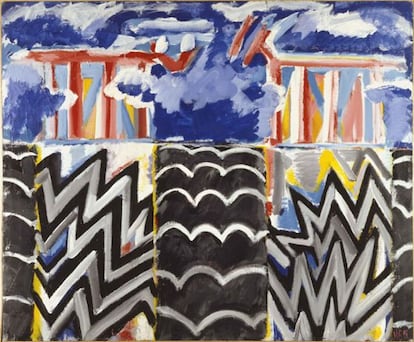Painting in Transition
Five post-Franco artists in search of a strategy

During the end of the 1970s and the start of the 1980s, right in the middle of Spain’s transition to democracy, a number of artists were responsible for a change in painting that reacted against the traditional avant-garde in Europe (Picasso, Matisse) and the US (Willem de Kooning, Robert Motherwell). They didn’t act as a group; rather, each of them was searching for their own originality in a society in which everything was still yet to be defined.
Alfonso Albacete, Miguel Ángel Campano, Ferran García Sevilla, Juan Navarro Baldeweg and Manolo Quejido are the five stars of Idea: Painting-Force. On the hinge between the 70s and the 80s, which runs at the Reina Sofía Museum’s Palacio de Velázquez in the Retiro Park until May 18. The palace’s vast halls have been divided into five parts featuring 10 works by each artist, all created between 1976 and 1984. An installation by Baldeweg, Interior V. Luz y metales (1976), serves as a link between the pieces. Revolving around a swing, it’s an invitation to sway by a world of dazzlingly colorful large-format works in which the figurative sits calmly with the abstract.
“They are artists whose work lies in the margins between different forms of representation,” explains Reina Sofía director Manuel Borja-Villel. “They look at the reality outside and they look at the great masters — Poussin, Velázquez — with the aim of pictorial practice in mind.”
Curator Armando Montesinos says the show tries to examine a period rather than a collective of artists. “It was an enormously active time, but it was weak in infrastructure. Museum spaces for contemporary art were scarce and the galleries, emerging. Nevertheless it was brimming over with creativity. It was looking for internationalization at any cost and thinking about a market that didn’t exist at the time.”
The only apparent link between the artists is their individual search for their own creative strategy. Albacete’s landscapes of dead nature combine the figurative and the abstract; Baldeweg produced installations as well as bright canvases in the style of Picasso or Matisse; while Quejido’s cards mix realism and pop art. “The problem was how to continue painting after having visited the Prado Museum,” the latter says. “The personal search was the only solution.”
Idea: Pintura Fuerza. En el gozne de los años 70 y 80. Until May 18 at Museo Nacional Centro de Arte Reina Sofía, Palacio de Cristal, Parque del Retiro, Madrid. www.museoreinasofia.es
Tu suscripción se está usando en otro dispositivo
¿Quieres añadir otro usuario a tu suscripción?
Si continúas leyendo en este dispositivo, no se podrá leer en el otro.
FlechaTu suscripción se está usando en otro dispositivo y solo puedes acceder a EL PAÍS desde un dispositivo a la vez.
Si quieres compartir tu cuenta, cambia tu suscripción a la modalidad Premium, así podrás añadir otro usuario. Cada uno accederá con su propia cuenta de email, lo que os permitirá personalizar vuestra experiencia en EL PAÍS.
¿Tienes una suscripción de empresa? Accede aquí para contratar más cuentas.
En el caso de no saber quién está usando tu cuenta, te recomendamos cambiar tu contraseña aquí.
Si decides continuar compartiendo tu cuenta, este mensaje se mostrará en tu dispositivo y en el de la otra persona que está usando tu cuenta de forma indefinida, afectando a tu experiencia de lectura. Puedes consultar aquí los términos y condiciones de la suscripción digital.








































